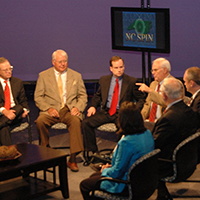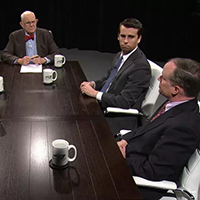NC is attractive, but with problems
Published January 17, 2015
by Rob Christensen, News and Observer, January 16, 2015.
As North Carolina’s legislature returned to Raleigh last week, it might be worth looking at the State of the State.
An examination of the statistics would suggest that North Carolina is an attractive, business friendly state, with moderate taxes, but which is still struggling with a legacy of poverty and under-funded schools.
Here are a few statistics and points to consider.
Taxes. North Carolina is in the middle, neither a low tax state nor a high tax state. North Carolina ranked 25th among the 50 states in state and local tax rates in 2014, according to the Tax Foundation, a conservative foundation based in Washington. You have to compare state and local taxes because different states finance different government functions at different levels. For example, in North Carolina schools are financed largely by the state, while in many states they are largely financed by local government. The report included recent tax cuts passed by the legislature.
Teaching. North Carolina is the worst state for teachers in the country, according a report last fall by the personal finance website WalletHub.com. It ranked North Carolina 51st behind every state and the District of Columbia. The report does not include teacher salaries passed by the legislature last year, which could improve North Carolina’s standing slightly. Using statistics compiled by the National Center for Education Statistics, the U.S. Census Bureau, the U.S. Bureau of Labor and other groups, WalletHub looked at such factors as public school per-student funding, 10-year change in teacher pay, safety of schools and teaching wage disparities.
Public schools. Despite the lackluster record regarding teachers, the public schools are doing better than you think. One of the best measures for how North Carolina public school students stack up against their peers across the country and in other countries is the National Assessment of Educational Progress (NAEP), a program known as “The Nation’s Report Card.” NAEP, which samples students in the fourth and eighth grades in science and math, found North Carolina students in 2013 performing above the national average and above many industrialized countries.
Attracting business. Numerous studies have judged North Carolina to be one of the most business-competitive states in the country. Among them is a survey by cnbc.com released last year that rated North Carolina fifth in the nation. (Georgia was first and Rhode Island was last.) The survey was based on 56 measures of competitiveness developed using input from business groups, economic development experts, companies and the states themselves.
Attracting people. The Tar Heel state ranked third in the country in 2014 among the top moving destinations in the country for families relocating for jobs and retirement, according to an annual study released by United Van Lines, the moving company. The two states ahead of us were Oregon and South Carolina.
Unemployment. North Carolina had a 5.8 percent rate in November 2014, ranked 25th in the country along with Arkansas, Florida and Massachusetts. It had been among the highest unemployment rates during the height of the recession. North Carolina has had the second-highest loss of manufacturing jobs in the country since 1995.
Poverty. North Carolina is a poor state. The state had the eighth-highest poverty rate in the country at 17 percent, according to the U.S. census. As the saying goes, thank God for Mississippi – and New Mexico, Texas, Arkansas, Arizona, Kentucky and Georgia. The poverty rate varies among groups: whites at 13 percent, blacks at 27 percent and Hispanics at 34 percent.
Spending. North Carolina state government spending has grown only modestly in this century. Between 2001 and 2011, North Carolina state government spending per capita grew 18.3 percent, making it the 45th fastest-growing state government in spending in the country, according to a recent report by the Tax Foundation.
January 17, 2015 at 11:32 am
Richard Bunce says:
Comparing to other States is foolish. If all States offer great K-12 education systems, who cares who is at the bottom. If all States offer poor (closer to current conditions) K-12 education systems, who cares who is at the top.
January 17, 2015 at 11:34 am
Richard Bunce says:
Teacher pay is a metric without a purpose for the goal of the education system... a far better metric would be what percentage of parents would use education vouchers if offered. A subset of that answer is usual more than 100% of the vouchers available.







